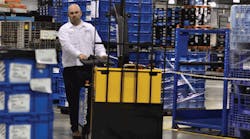As a participant in the last of MHI’s recent series of Roadmap forums where supply chain professionals speculated about the state of material handling and logistics by 2025, I expected to hear a lot about really cool automation. I didn’t expect to hear about bikes.
But believe it or not, many fellow think-tankers believe that consumer demand and a population shift to urban centers will make messengers on bikes key players in the new vision of e-commerce order fulfillment. This perspective isn’t just part of a 50,000 ft overview of where things are headed, but it actually identifies the last 50 feet of a shipment as the shipper’s new competitive advantage.
This belief accompanies several other assumptions on our trends list:
- We’ll need high-speed fulfillment operations to support these messengers as they make deliveries in crowded urban areas populated by consumers living in high-rise housing;
- We’ll need to establish coordinated communications between distribution centers, stores and urban messengers driving cars or bikes;
- Sensors throughout the supply chain will feed data to forecasting models, including data from the point of product consumption—as reported by a consumer’s refrigerator;
- This will lead to predictive and anticipatory modeling, allowing supply chains to meet demand before it is realized.
This stuff may seem far-fetched, especially considering we’re talking about a 12-year timeframe—but the enabling communications infrastructure is already taking shape.
I interviewed Mike Lee about this not long after attending MHI’s Roadmap session. He’s CEO of Airclic, which offers a hosted cloud-based business application that sends messages and electronic documents to a truck driver’s—or bike messenger’s—smart phone. The premise of our discussion was whether this kind of setup could lead to the rise of “lifestyle couriers” and the death of warehousing. His argument is that Google, Amazon, eBay, and even Wal-Mart and Target, are already piloting same-day fulfillment of orders and using stores as warehouses.
To make these deliveries, retailers will increasingly be using third-party logistics operators who will in turn contract with these couriers. Lee says these are self-employed people who will make one or two deliveries a month in their spare time using the trunks of their cars or even the baskets on their bikes—and the smart phone on their belts.
“The smart phone technology is an enabler,” Lee said. “Without it, this would be a very difficult thing to pull off cost effectively.”
In fact, he sees it as a retailer equalizer, especially during seasonal business peaks.
“Think about parcel delivery companies that are handling a lot of these e-retail orders around the holidays,” he said. “Their volumes quadruple. To handle these peaks they won’t buy more vehicles or hire full time drivers, they’ll augment what they have with lifestyle couriers. Smaller and smaller businesses will have access to this type of technology that otherwise would have been unaffordable because they don’t have an IT staff. They’ll pay for the service as it’s used, on a transactional basis.”
Welcome to the “supply chain on demand” business. This smart-phone-supported e-commerce may even be supported by e-bikes, according to a new report.
The study, from Lux Research, predicts that the market for energy storage technology (i.e., lithium-ion batteries and hydrogen fuel cells) in mobile applications will grow from today’s $28 billion to $41 billion by 2018. The report says transportation will be the prime mover in this growth and that this market’scompound annual growth rate through 2018 will be 22% in e-bikes, 34% in hybrid vehicles and 22% in plug-in hybrids.
These researchers even present an upbeat picture of warehousing, at least where energy use is concerned. This is an environment that has been using electric transportation for decades—in the form of lift trucks powered by lead acid batteries. Not only will that market continue to prosper, but Lux researcher Cosmin Laslau projects that 62,000 fuel-cell-powered forklifts will be sold by 2030, generating revenues of $973 million. He cites the value proposition of faster fueling and shorter equipment downtime by eliminating charge times and battery change-outs.
Fuel-cell forklifts and lifestyle messengers may never break out of the “specialty” category of material handling and logistics, but by 2025, for the “supply chain on demand” model to work, special--yet governed by standards--will be essential.



